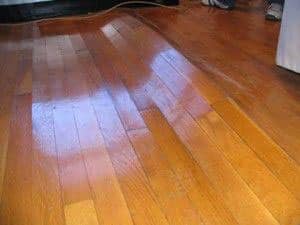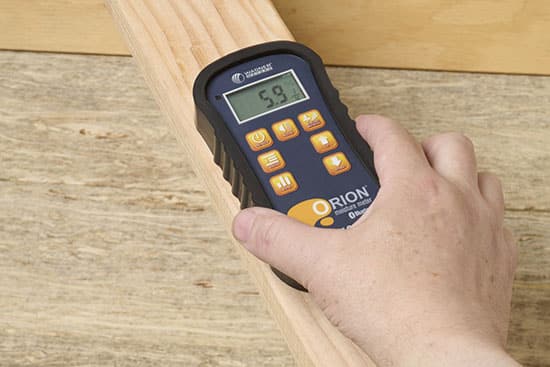A Comprehensive Guide to Determining Wood Moisture Content

Wood can become too dry if left in a kiln for too long.
How frustrated would you be if you spent a lot of time and money on your latest woodworking project only to discover the wood is warping and bending out of shape?
While the very thought of a ruined custom project may make you clench your jaw, the reality is, this scenario is all too possible for anyone who fails to check the moisture content of their wood.
Fortunately, we’ve got a simple, all-in-one guide right here that will help you avoid those pitfalls. We’ll see why moisture content is one of the most crucial factors to account for when deciding whether your wood is ready to work with. On top of that, we’ll tell you everything you need to know about getting accurate moisture measurements.
Keep scrolling through this article to learn:
- What wood moisture is and why it matters
- Ideal moisture content
- How to know when your wood is fully dry
- Whether wood can ever be “too dry”
- The natural drying process of wood
- Why accurate moisture measurements matter
- What sets our moisture meters apart
Let’s get to it!
What Wood Moisture Is (And Why It Matters)

High moisture levels can cause wooden floorboards to buckle.
Wood moisture content, or MC, is the moisture within a piece of wood. This consists of both free water—water located in wood pores—and bound water—water chemically bound to cell walls.
Wood is a hygroscopic material, meaning that its moisture content can increase or decrease as it absorbs or releases moisture in response to environmental conditions.
Changes in wood moisture content are especially critical for wood being used in a woodworking project. Wood can swell, shrink, or warp as it absorbs or releases moisture. This can lead to misshapen wood and structurally unstable projects.
That’s why it’s so important to measure the moisture content of your wood before you use it in a project. Wood moisture testing will tell you whether your wood has acclimated, or stabilized to the point where it’s not swelling or shrinking anymore.
And at this point, your wood is ready to use because it’s reached its ideal moisture content.
Understanding Ideal Moisture Content
In general, the ideal moisture content for any given piece of wood is usually within 6% to 12%. But the EMC, or equilibrium moisture content, is the specific number you need. EMC is the moisture content a piece of wood will acclimate to in a specific environment.
The EMC can differ from region to region as hot and dry climates have different moisture conditions than cold and wet ones. The EMC you aim for will also depend on whether your project will be indoors or outdoors.
Outdoor projects are exposed to more moisture than the ones inside. For this reason, the ideal moisture content for the wood of outdoor construction projects will be higher than that of, say, a coffee table.
As a matter of fact, most people are content to use wet wood in low-stakes outdoor projects. This is because most people aren’t overly concerned with their decks and fences warping or shrinking over time.
Wood used in construction is a different story, though.
Wood used for wall studs and other structural building materials should have a moisture content below 19%. Any higher and the wood could grow mold. That’s why it’s so important to check the moisture content of the material.
How to Tell When Your Wood is Dry
You can tell your wood is dry (has reached the EMC) by using either:
- The oven-dry test method
- The moisture meter method
Oven-dry testing is the more accurate way of measuring moisture content, although it does have some drawbacks. It can be expensive and time-consuming, and it’s also a pretty complicated process that damages the samples you’re testing, rendering them unusable.
That’s why most people opt to use moisture meters. They’re faster and less expensive, and yet, they’re still a very effective means of finding an accurate moisture content.
Several studies show that our pinless meters are especially accurate and can provide quick results regardless of wood size or ambient temperature—as long as you’re measuring wood with a flat surface.
And with these measurements, you’ll be able to determine whether your wood needs to gain or lose moisture. In most cases, you’ll be looking to decrease the moisture content of your wood, although there might be times when your wood is dry enough already.
Can Wood Be Too Dry for Woodworking?
Though most woodworkers and industry professionals are mainly concerned with their wood containing excess moisture, it’s possible for wood to become too dry, particularly from excessive kiln drying or other overly dry conditions.
This can be problematic as the wood could split when it becomes too dry or swell the next time it’s exposed to moisture. Over-drying could damage the surface of the wood and change its dimensions.
Monitoring the moisture content of your wood as it dries can prevent over-drying in the first place.
The Natural Drying Process of Wood
Although you could stick wood in a kiln to dry, wood does have a way of drying on its own.
All you have to do is leave wood in a stable, dry environment. It will naturally begin to acclimate in response to the EMC of the surrounding air. If the surrounding environment has less moisture than the wood, the wood will begin to release moisture, drying itself.
The time period for this process could vary from several months to a year, depending on:
- The type of wood
- The thickness of the wood
- Environmental conditions
The slow rate of this process is the reason many people turn to kiln-dried wood.
Whatever method you choose, measuring moisture is essential to determine when your wood is ready to use.
The Importance of Accurate Moisture Measurement

The Orion 950 meter provides content moisture percentages for wood.
Failing to account for wood moisture can cause wood damage like shrinking, warping, swelling, and cracking, which could undermine the integrity of your entire project.
We know that woodworking requires you to put a lot of time and money into custom projects. It’d be a terrible waste to see your project fall apart all because you neglected to acclimate your wood.
Being aware of the wood moisture content can help you avoid this waste and know when the wood is ready for use.
And in order to get accurate readings, you need to use a quality meter.
Here at Wagner Meters, we’ve got pinless moisture meters that are some of the most accurate meters in the industry. One study reports that our meters are more consistent than resistance meters in determining moisture content.
They’re also simple and straightforward to use, with plenty of bonus features to make your job that much easier. Check out this training video to see how easy it is to use the Orion® 950.
On top of having more accurate meters, we’ve also got some tips to help you gather the most accurate readings.
Tips for Using Moisture Meters
To maximize the accuracy of our pinless moisture meters, we recommend you:
- Make sure you’re scanning the right kind of wood (chemically treated wood can skew moisture readings)
- Make sure the meter is operational (working batteries and undamaged)
- Make sure your meter is set to scan the wood species you’re working with
- Apply adequate pressure to push the meter scanning plate against the wood
- Test multiple times in different places to check the readings throughout the piece of wood
- Test near the middle of the board, where you’ll get a more accurate reading
- Avoid using pinless meters on boards with surface moisture
- Avoid scanning above wood deformities
- Avoid scanning wood next to metal
Above all, we hope you remember that, when accuracy’s the name of the game, there’s no better place to look than Wagner Meters!
What Makes Our Moisture Meters an Excellent Option
Our moisture meters are some of the most accurate moisture meters around. They also:
- Can be re-calibrated in the field
- Come with a wood species guide
- Can give relative readings of some non-wood materials
On top of that, our Orion 950 meters can:
- Measure temperature and relative humidity
- Calculate EMC percentages
- Gather measurements at two different depths
- Collect and store data
Our state-of-the-art moisture meters make moisture measurement much easier. All you have to do is press the meter’s scan plate against the wood, and you’ll have an accurate reading in seconds.
Visit our shop to find the right meter for you!

Wagner Meters is a family-owned American business that aims to provide solutions in moisture measurement technology that will enhance the quality and value of each customer’s project. With an almost 60-year legacy of innovation, Wagner continues to be a resource for both individual craftsmen and high-performance commercial endeavors.
Last updated on March 17th, 2025



